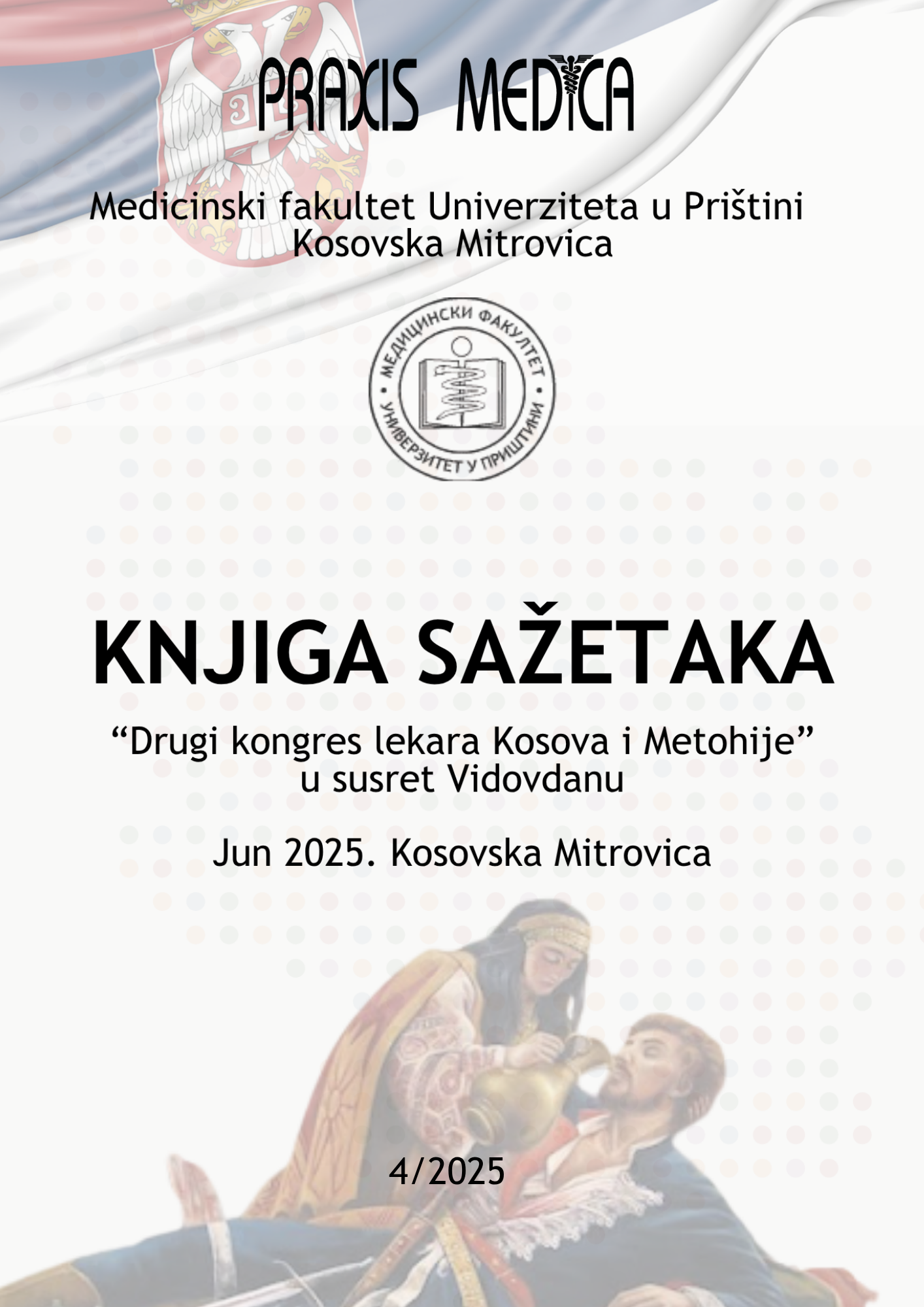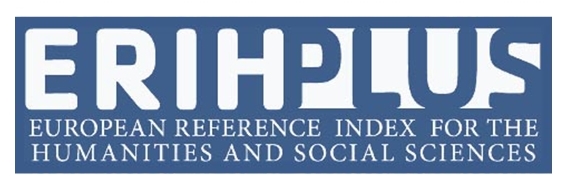Current issue

Volume 53, Issue 4, 2025
Online ISSN: 2560-3310
ISSN: 0350-8773
Volume 53 , Issue 4, (2025)
Published: 30.06.2025.
Open Access
All issues
Contents
30.06.2025.
Professional paper
KT SKOR TEŽINE BOLESTI KAO PREDIKTOR MORTALITETA KOD HOSPITALIZOVANIH COVID-19 PACIJENATA
Uvod: Kompjuterizovana tomografija (KT) grudnog koša je značajna radiološka metoda u dijagnostikovanju COVID-19, planiranju lečenja i proceni
odgovora na primenjenu terapiju. KT skor ili indeks težine bolesti (eng. Computed Tomography Severity Score Index-CTSS) se smatra korisnim
sredstvom u proceni obima zahvaćenosti pluća inflamatornim promenama, što može pomoći u predviđanju smrtnog ishoda kod obolelih.
Cilj rada: Ispitati ulogu KT skora težine bolesti na prijemu u zdravstvenu ustanovu u predikciji letalnog ishoda kod pacijenata obolelih od COVID-19.
Metode rada: Ovom studijom obuhvaćeno je 176 pacijenata sa potvrđenom infekcijom SARS-CoV-2 koji su hospitalizovani u Kovid bolnici Kliničko
bolničkog centra Kosovska Mitrovica od jula 2020. do marta 2022. godine. Svi ispitanici su na prijemu bili upućivani na pregled kompjuterizovanom
tomografijom grudnog koša. Određivanjem KT skora težine bolesti utvrđivan je procenat pluća zahvaćenih COVID-19 pneumonijom i oblik bolesti
(blagi, umeren i težak). Praćenjem ishoda bolesti sagledana je prognostička uloga inicijalnog KT pregleda grudnog koša.
Rezultati: Najveći broj ispitanika je imao umereni oblik bolesti. Uočava se značajna razlika u distribuciji plućne inflamacije, sa jednostranom i
perifernom lokalizacijom promena koje su najčešći nalaz kod blagog oblika pa sve do obostranih promena koje zahvataju veću površinu pluća kod
teških oblika bolesti. Najučestalije promene viđene inicijalnim KT pregledom su senke izgleda „mlečnog stakla“, dilatirani krvni sudovi i
konsolidacije.
Zaključak: Vrednosti ukupnog KT skora veće od 17 su odličan diskriminatorni kriterijum letalnog ishoda kod pacijenata obolelih od COVID-19. Pomoću ovog načina skorovanja
stepena plućne inflamacije viđene kompjuterizovnom tomografijom na prijemu u zdravstvenu ustanovu može se predvideti ishod bolničkog lečenja. Sveobuhvatnim
sagledavanjem pacijenta na prijemu može se izvršiti adekvatna klinička procena i samim tim primena odgovarajućih terapijskih protokola u lečenju COVID-19.
Ključne reči: COVID-19, kompjuterizovana tomografija grudnog koša, KT skor težine bolesti, smrtni ishod.
Aleksandra Milenković, Simon Nikolić, Jelena Aritonović Pribaković
01.12.2019.
Professional paper
Anatomical variants of circle of Willis
Introduction: The circle of Willis is the major source of collateral blood flow between the carotid and vertebrobasilar system. Its potential depends on the presence and size of arteries that vary greatly among normal individuals and therefore their adequate observation by a radiologist is necessary. Aim: Determine the type of the circle of Willis and their frequency. Determine the type, frequency and localization of anatomical variants of arteries, as well as their average diameter. Compare these variables according to the age and gender of the examinees. Material and methods: A retrospective study was performed at the Center for Radiology of the Clinical Center Nis during 2017. All subjects underwent CT or MR angiography according to a standard endocranial protocol. The anterior and posterior parts of the circle were specially observed, with an emphasis on the presence or absence of anatomical variants of the arteries, with the measurement of their diameter. The obtained data were classified into variants of the front or rear part of the ring as well as the type of ring according to integrity. The frequency of these variables and their comparison by sex and age were measured. Results: The research included 92 examinees. According to the configuration of the Willis arterial ring, the adult type was the most often represented (71.7%). The most common type in terms of integrity was partially complete. The most common anatomical variants obtained in our work was aplasia of AcoA (27.2%) and aplasia of one or both PCoA (21%). PcoA hypoplasia was occured in women with a frequency of 13.5% while in men it was not present. Conclusion: Adequate understanding of the morphology of the circle of Willis by radiological methods is a good guide for neurosurgical and radiological intervention procedures. In this way, potentially significant neurological complications and the risk of morbidity and mortality could be reduced.
Aleksandra Milenković, Slađana Petrović, Simon Nikolić, Branislava Radović, Aleksandra Ilić, Miloš Gašić, Bojan Tomić
01.12.2019.
Professional paper
Errors and artifacts on radiographs
Introduction: The process of recording a patient includes a procedure with several separate segments during work that together provide the imaging to be obtained for adequate radiological analysis. Throughout the process, it is possible to experience errors that create artifacts on X-rays which ultimately results in an inadequate recording that is not for valid analysis. Aim: Determine the total number of radiological films that are not for valid analysis. Sort out and analyze errors in radiographs according to the work process. Provide recommendations for improving the quality in the process of recording the patient. Material and methods: A prospective study was conducted at the Radiology Clinic of the Clinical Hospital Center Pristina-Gracanica, for two calendar years. All films that are not for valid analysis were considered. The radiological procedure of patient imaging was broken down into logical segments so that possible errors could be observed. We have summarized the causes of the artifacts in five appropriate groups (errors made by the recording technique, during the acquisition of the image, caused by the object of recording, during the processing of films in an automated machine and improper handling of films). Results: The total amount of used X-ray films is 32600 pieces, of which 242 (0.74%) were errors and artifacts. The most common format of a film with an error or artifact was 30x40 cm. A frequency of errors according to the cause of the occurrence is classified into appropriate groups. The largest number was in a group 1 - 155 (64.04%), in a group 2 - 3 (1.24%), in a group 3 - 13 (5.37%), in a group 4 - 67 (27.69%), and in a group 5 - 4 (1.66%). Conclusion: In the proper systematization of all observed errors and artifacts of X-ray film, it allows us to realise the place of error during the whole process of recording and processing of the film. We hereby wish to propose their elimination and improve the quality of the radiology department.
Simon Nikolić, Aleksandra Milenković, Bojan Tomić, Branislava Radović, Miloš Gašić
01.12.2017.
Professional paper
Analysis of radiological cabinets condition in the territory of Kosovo and Metohija
Introduction: Radiological diagnostics is the dominant diagnostic discipline in medicine. The level of technical equipment of radiological departments directly affects many aspects of importance for the diagnosis of a large number of pathological conditions and, therefore, the progress in the treatment of patients. Aim: The research analyzes the existing situation in radiological cabinets on the territory of AP Kosovo and Metohija. Particularly important elements will be analyzed for the functioning of the radiology service. An analysis of the obtained results gives recommendations in order to improve radiological diagnostics. Metods: A survey was conducted to obtain relevant data. A questionnaire consisting of segments containing basic elements for determining patients' accessibility criteria, equipping the cabinet with equipment and employing professional staff was designed. This formulated questionnaire was sent to radiological departments in health institutions on the territory of AP of Kosovo and Metohija, which are part of the Ministry of Health of the Republic of Serbia. Results: The highest percentage of radiological equipment is represented in KBC Kos. Mitrovica and KBC Pristina-Gračanica, a total of 54%. The percentage of medical staff is at KBC Kos Mitrovica radiologist 50%, work technician 36%. This is followed by KBC Prishtina-Gračanica with 25% radiologists and 27% of radiological therapists. Conclusion: The basics of radiological diagnosis are conventional x-ray techniques. Tertiary health care does not adequately possess radiological high-tech modes of computerized tomography and magnetic resonance. Staff training is required in order to re-establish existing knowledge and skills development that are followed by the continuous professional development of technology applied in radiological practice.
Simon Nikolić, Bojan Tomić, Aleksandra Milenković, Branislava Radović, Miloš Gašić
01.01.2017.
Professional paper
The determinants of initial bleeding and rebleeding of duodenal peptic ulcers
Acute bleeding of the upper gastrointestinal tract is an urgent condition with high morbidity, and a significant mortality despite advanced diagnostics and therapy. The goal is to investigate the determinants of the severity of duodenal peptic ulcer bleeding. The research included 304 patients hospitalized for acute bleeding from the upper part of gastrointestinal tract in a five year period. They had been treated in the Clinical Hospital Center Bežanijska Kosa in Belgrade. The diagnosis was made via gastroduodenoscopy. Out of the 304 patients, 197 (65%) suffered from bleeding peptic ulcer. 144 (73,1%) patients suffered from bleeding duodenal ulcer, most frequently with bulbar localization 124/86 (12%); 78 (62,9%) with a duodenal bulb back wall lesion. 48 (35,1%) of the bleeding duodenal ulcers were in the Forrest Ib stage, in 68 (47,2%) patients the size of the ulcer lesion was between 1,1-2,0 cm. A statistically positive correlation was determined between the duodenal ulcer lesions and the intensity of the bleeding (p<0,005). With 68/79/86,1% patients treated endoscopically, haemostasis was successful, whereas in 13/19,1%, rebleeding was localized in 11/84,6% in the duodenum bulb bask wall.
Bratislav Lazic, Slavisa Matejic, Simon Nikolic, Jasna Gacic, Dragan Gacic, Petar Jovanovic, Bozidar Odalovic





